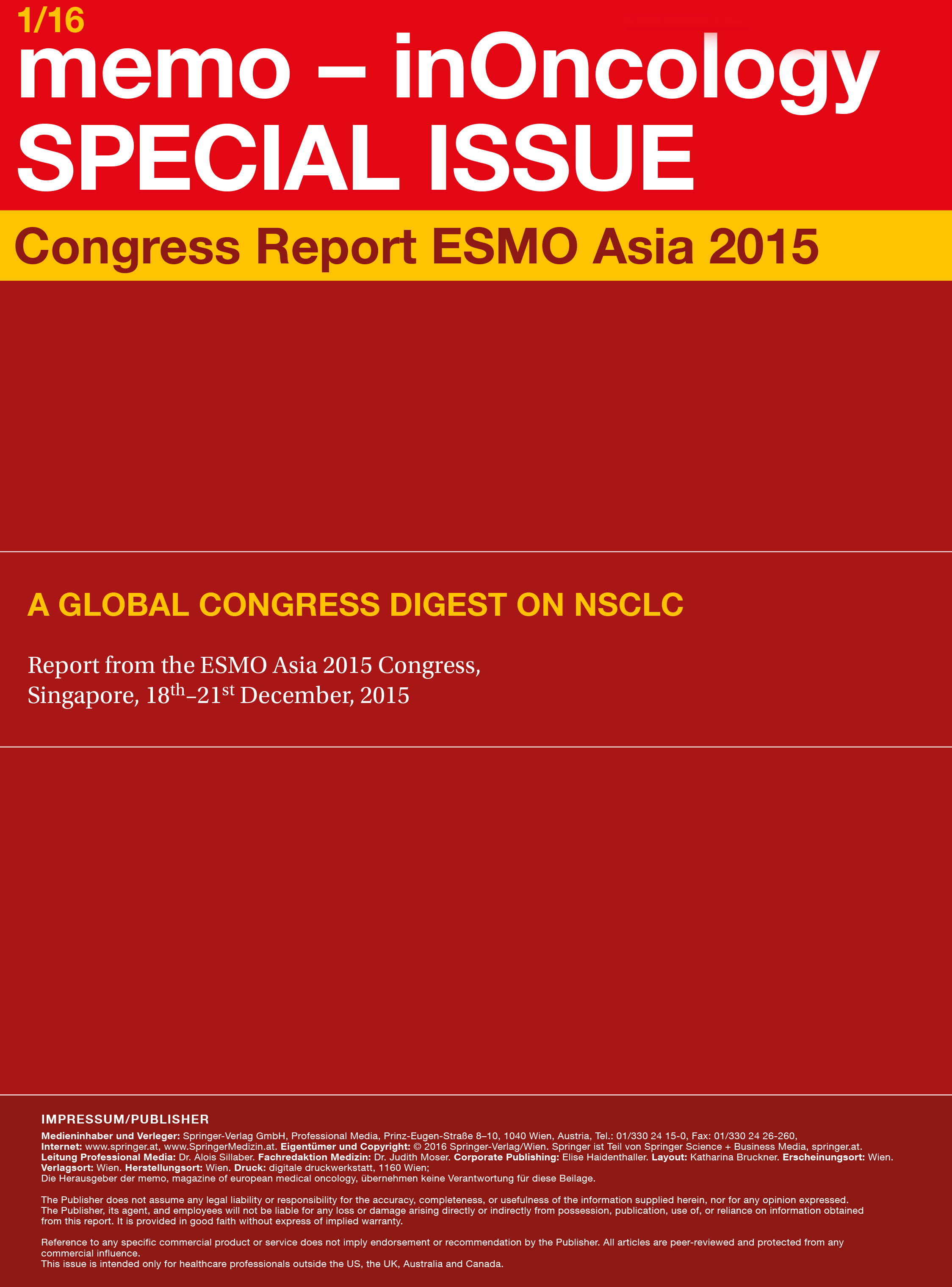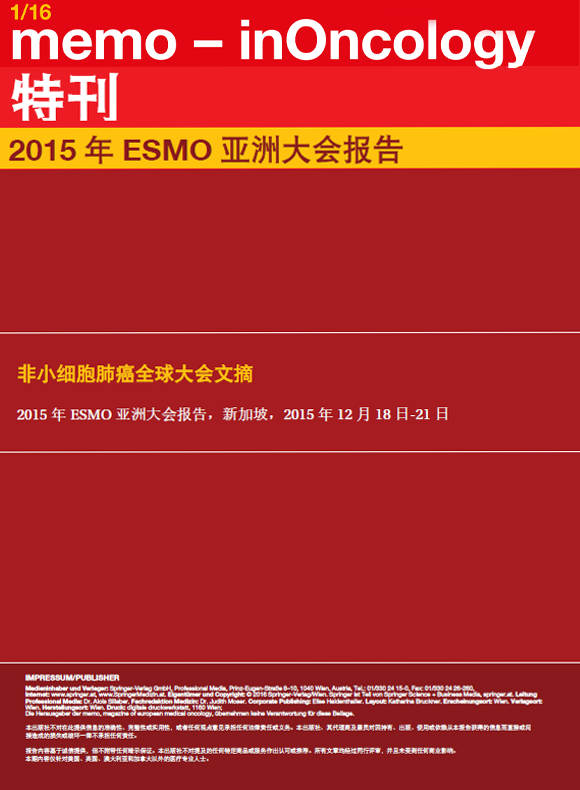ESMO Asia 2015 – Singapore
Lecture Board: Maximilan Hochmair MD, Robert Pirker MD, Martin Reck MD, Suresh Senan, MD, Frances Shepherd MD
Medical Writer: Judith Moser, MD
Preface – ESMO Asia 2015
Preface – ESMO Asia 2015 Frances A. Shepherd Dear Colleagues, My career in lung cancer care started at a time when nihilism prevailed and the standard approach in advanced disease consisted of best supportive measures. No treatments were available in which the benefits outweighed the toxicity.
EGFR-mutation-positive NSCLC: expanding the data pool for established treatment options
EGFR-mutation-positive NSCLC: expanding the data pool for established treatment options Subgroup analyses of LUX-Lung 3 and 6 Non–small-cell lung cancer (NSCLC) with activating epidermal growth factor receptor (EGFR) mutations represents a defined molecular subset of lung cancer that can be targeted with EGFR tyrosine kinase inhibitor (TKI) therapies.
Disease progression on EGFR TKI therapy: what to do after erlotinib, gefitinib and afatinib?
Disease progression on EGFR TKI therapy: what to do after erlotinib, gefitinib and afatinib? First-line treatment for patients with EGFR-mutation-positive NSCLC includes the first-generation reversible EGFR TKI inhibitors erlotinib and gefitinib, and the second-generation ErbB family blocker, afatinib. These drugs can elicit dramatic responses, but acquired resistance generally limits the successful long-term treatment.
Risks and chances in patients with oligometastatic disease
Risks and chances in patients with oligometastatic disease Against the background of improved systemic therapies, there are rising expectations with regard to the potential cure of NSCLC patients who have a limited number of haematogeneous metastases.
Immunotherapy: anti-tumour activity despite extensive pretreatment
Immunotherapy: anti-tumour activity despite extensive pretreatment The anti-PD-1-antibodies pembrolizumab and nivolumab have been shown to be active in lung cancer. Pembrolizumab is a high-affinity, humanised, monoclonal IgG4κ antibody against PD-1 that prevents the interaction of the receptor with PD-L1 and PD-L2.
PD-L1 expression is a nightmare in terms of complexity
PD-L1 expression is a nightmare in terms of complexity Martin Reck, MD, PhD, Department of Thoracic Oncology, Lung Clinic Grosshansdorf, Germany Immunotherapies offer advantages in unselected patients. However, the implementation of biomarkers would be highly welcome. One of the reasons for this would be containment of the financial strain on health systems, as physicians could then exclude patients who are unlikely to benefit from treatment. Where are we today regarding biomarker de
Immunotherapy: management of toxicity
Immunotherapy: management of toxicity The basis underlying the toxicities of immune checkpoint inhibitors is their promotion of T-cell activity in a physiological manner. “The amplification of the immune system results in autoimmunity,” explained Ross Soo, MD, FRACP, National University Cancer Institute, Singapore.
Intracranial activity of ceritinib in crizotinib-pretreated and crizotinib-naïve ALK-positive NSCLC patients
Intracranial activity of ceritinib in crizotinib-pretreated and crizotinib-naïve ALK-positive NSCLC patients In 3 % to 5 % of cases, lung cancer is associated with ALK rearrangement and can therefore be targeted with the ALK inhibitors crizotinib and ceritinib. While crizotinib is the standard first-line therapy, ceritinib has gained approval for use with patients who are crizotinib-refractory.
序言
序言 Frances A. Shepherd 亲爱的同事们, 我在肺癌治疗领域的职业生涯开始之初,正值虚无主义盛行之时,而针对晚期疾病的标准方法还是由各种最佳支持性措施构成。那时尚没有任何受益大于毒性的治疗方法。化学疗法的到来终于使得生存的可能性得以提高;此外,这一策略还能够缓解症状和改善患者的生存质量。自此以后,以铂类为基础的化学疗法业已成为首选一线治疗方案。 在至少十年里,人们在各种试验中对双药化疗进行了比较,但是都没有得出相比而言更优异的临床疗效。最值得注意的是,对于晚期疾病患者
EGFR 突变阳性非小细胞肺癌:扩大用于既定治疗方案的数据 池
EGFR 突变阳性非小细胞肺癌:扩大用于既定治疗方案的数据 池 LUX-Lung 3 和 6 的亚群分析 伴有激活的表皮生长因子受体(EGFR )突变的非小细胞肺癌(NSCLC)代表了肺癌的一个确定的分子亚型,该亚型能够用 EGFR 酪氨酸激酶抑制剂(TKI)疗法进行靶向治疗。埃罗替尼(erlotinib)、吉非替尼(gefitinib)和阿法替尼(afatinib)都已被批准作为 EGFR 突变阳性NSCLC 的一线治疗选择。第一代 TKIs埃罗替尼和吉非替尼通过可逆抑制EGFR 来发
使用 EGFR TKI 疗法后的疾病进展:在埃罗替尼、吉非替尼和阿 法替尼之后还有哪些手段?
使用 EGFR TKI 疗法后的疾病进展:在埃罗替尼、吉非替尼和阿 法替尼之后还有哪些手段? 用于EGFR 突变阳性 NSCLC 患者的一线治疗方案包括第一代可逆 EGFR TKI抑制剂埃罗替尼和吉非替尼,以及第二代 ErbB 家族阻断剂阿法替尼。这些药物能够引起强烈的反应,但获得性耐药往往限制了成功的长期治疗。在大多数患者中,由于耐药性而最终仍会发生肿瘤进展。 T790M:头号罪魁祸首 图 1: EGFR 突变阳性肿瘤中获得性耐药机制的相对频率 获得性耐药的最常见机制是在 EGFR
寡转移疾病患者的风险与机会
寡转移疾病患者的风险与机会 在全身治疗不断进步的背景下,对于患有有限数目血行转移瘤的 NSCLC 患者的潜在治愈期望与日俱增。Suresh Senan 博士(MRCP、FRCR 就职于荷兰阿姆斯特丹 VU 大学医学中心[1])解释称:“大多数研究将寡转移定义为一到三个或者一到五个病灶”[1]。根据临床情况,存在同时性(在原发性肿瘤诊断时检出的)和异时性(在对原发性肿瘤治疗后出现的)寡转移瘤。如 Senan 博士所指出,能够区分这这两者的时间间隔不是标准化的,但通常使用 6-12 个月的时
免疫疗法:大量预治疗之后令人瞩目的抗肿瘤活性
免疫疗法:大量预治疗之后令人瞩目的抗肿瘤活性 抗 PD-1 抗体派姆单抗( pembrolizumab )和纳武单抗(nivolumab)已被证明对肺癌具有活性。派姆单抗是一种抗 PD-1 的高亲和力人源化单克隆 IgG4κ 抗体,其能够阻止带有 PD-L1 和 PDL2 的受体发生相互作用。KEYNOTE-001 试验证明,派姆单抗对晚期 NSCLC 具有显著的抗肿瘤活性,其在 PD-L1 肿瘤比例评分(TPS)方面的结果得到提高,达 ≥50% [1]。TPS 反映了 PD-L1 在肿
“PD-L1 表达如噩梦般复杂”
“PD-L1 表达如噩梦般复杂” 免疫疗法在未经筛选的病人中能产生有利作用。然而,生物标志物的使用是非常值得欢迎的。这样做的理由之一是出于遏制医疗系统中资金紧张的考虑,通过这样的措施让医生们能够排除不大可能从治疗中受益的患者。那么我们目前在生物标志物发展方面处于什么地位呢? 在免疫疗法中有两个问题紧密关联于生物标志物这一主题。首先,所有试图定义生物标志物的尝试都主要集中在作为疗效标志的反应性上。但是我们必须认识到,免疫疗法并不是靶向疗法,而且在这种治疗中并不一定能够观察到快速的肿瘤缩小。
免疫疗法:毒性管理
免疫疗法:毒性管理 免疫检查点抑制剂的毒性从根本上源于它们是以一种生理学方式促进 T 细胞活性。“免疫系统的放大导致自体免疫性疾病,”Ross Soo 解释称(Ross Soo 身为医学博士,FRACP,就职于新加坡国立大学癌症研究所)。 常见不良事件(AE)包括疲劳、厌食和关节痛。表示免疫相关不良事件(irAE)的英文术语通常以-itis 或-opathy 结尾。CTLA-4 抑制剂、PD-1/PD-L1 抑制剂及其联合用药可能引起发烧、寒战和嗜睡[1]。皮疹往往是斑状丘疹型,而肠胃道
在经克唑替尼预治疗和未经过克唑替尼治疗的 ALK 阳性非小细 胞肺癌患者体内色瑞替尼的颅内活性
在经克唑替尼预治疗和未经过克唑替尼治疗的 ALK 阳性非小细 胞肺癌患者体内色瑞替尼的颅内活性 在 3 %至5 %的病例中,肺癌与ALK 重排相关,因此可以利用 ALK 抑制剂克唑替尼和色瑞替尼进行靶向治疗。克唑替尼是标准的一线治疗药物,而色瑞替尼已被批准用于难以施用克唑替尼治疗的患者。在单组多中心 II 期ASCEND-2 和 ASCEND-3 研究中,色瑞替尼在经克唑替尼预治疗和未经ALK 抑制剂治疗的患者中都显示出临床活性[1, 2]。 Park 等人在 ESMO 亚洲大会上展示了
Immunotherapy represents an exciting new option, particularly in patients with squamous cell cancer, and in prior or current smokers. In the CheckMate 017 trial, the PD-1 inhibitor nivolumab provided clinically meaningful and statistically significant overall survival benefit independent of PD-L1 expression in a population of previously treated patients with advanced squamous-cell lung cancer.






